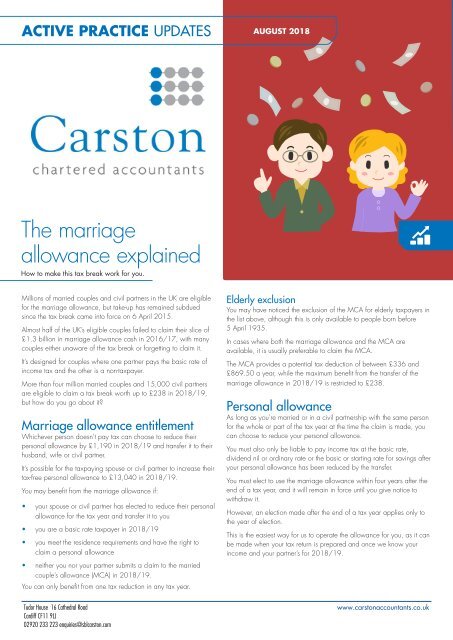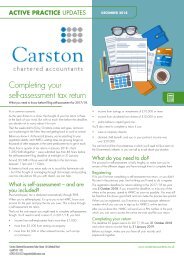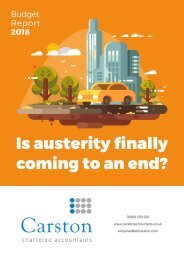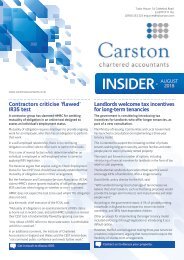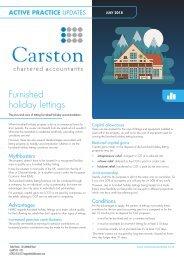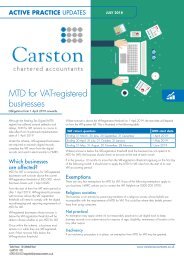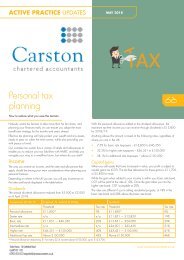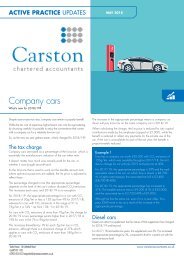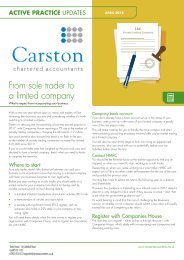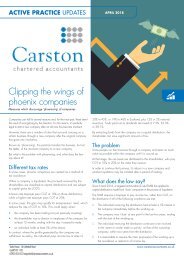The marriage allowance explained.
You also want an ePaper? Increase the reach of your titles
YUMPU automatically turns print PDFs into web optimized ePapers that Google loves.
ACTIVE PRACTICE UPDATES AUGUST 2018<br />
<strong>The</strong> <strong>marriage</strong><br />
<strong>allowance</strong> <strong>explained</strong><br />
How to make this tax break work for you.<br />
Millions of married couples and civil partners in the UK are eligible<br />
for the <strong>marriage</strong> <strong>allowance</strong>, but take-up has remained subdued<br />
since the tax break came into force on 6 April 2015.<br />
Almost half of the UK’s eligible couples failed to claim their slice of<br />
£1.3 billion in <strong>marriage</strong> <strong>allowance</strong> cash in 2016/17, with many<br />
couples either unaware of the tax break or forgetting to claim it.<br />
It’s designed for couples where one partner pays the basic rate of<br />
income tax and the other is a non-taxpayer.<br />
More than four million married couples and 15,000 civil partners<br />
are eligible to claim a tax break worth up to £238 in 2018/19,<br />
but how do you go about it?<br />
Marriage <strong>allowance</strong> entitlement<br />
Whichever person doesn’t pay tax can choose to reduce their<br />
personal <strong>allowance</strong> by £1,190 in 2018/19 and transfer it to their<br />
husband, wife or civil partner.<br />
It’s possible for the taxpaying spouse or civil partner to increase their<br />
tax-free personal <strong>allowance</strong> to £13,040 in 2018/19.<br />
You may beneit from the <strong>marriage</strong> <strong>allowance</strong> if:<br />
• your spouse or civil partner has elected to reduce their personal<br />
<strong>allowance</strong> for the tax year and transfer it to you<br />
• you are a basic rate taxpayer in 2018/19<br />
• you meet the residence requirements and have the right to<br />
claim a personal <strong>allowance</strong><br />
• neither you nor your partner submits a claim to the married<br />
couple’s <strong>allowance</strong> (MCA) in 2018/19.<br />
You can only beneit from one tax reduction in any tax year.<br />
Elderly exclusion<br />
You may have noticed the exclusion of the MCA for elderly taxpayers in<br />
the list above, although this is only available to people born before<br />
5 April 1935.<br />
In cases where both the <strong>marriage</strong> <strong>allowance</strong> and the MCA are<br />
available, it is usually preferable to claim the MCA.<br />
<strong>The</strong> MCA provides a potential tax deduction of between £336 and<br />
£869.50 a year, while the maximum beneit from the transfer of the<br />
<strong>marriage</strong> <strong>allowance</strong> in 2018/19 is restricted to £238.<br />
Personal <strong>allowance</strong><br />
As long as you’re married or in a civil partnership with the same person<br />
for the whole or part of the tax year at the time the claim is made, you<br />
can choose to reduce your personal <strong>allowance</strong>.<br />
You must also only be liable to pay income tax at the basic rate,<br />
dividend nil or ordinary rate or the basic or starting rate for savings after<br />
your personal <strong>allowance</strong> has been reduced by the transfer.<br />
You must elect to use the <strong>marriage</strong> <strong>allowance</strong> within four years after the<br />
end of a tax year, and it will remain in force until you give notice to<br />
withdraw it.<br />
However, an election made after the end of a tax year applies only to<br />
the year of election.<br />
This is the easiest way for us to operate the <strong>allowance</strong> for you, as it can<br />
be made when your tax return is prepared and once we know your<br />
income and your partner’s for 2018/19.<br />
Tudor House 16 Cathedral Road<br />
Cardiff CF11 9LJ<br />
02920 233 223 enquiries@sblcarston.com<br />
www.carstonaccountants.co.uk
<strong>The</strong> <strong>marriage</strong> <strong>allowance</strong> <strong>explained</strong><br />
Separation and divorce<br />
If you and your spouse or civil partner separate between the end of<br />
a tax year and the date your tax return is due, there’s a slight chance<br />
you’ll lose your eligibility for the <strong>marriage</strong> <strong>allowance</strong>.<br />
Cancelling the <strong>marriage</strong> <strong>allowance</strong> normally takes effect from the next tax<br />
year unless the <strong>marriage</strong> or civil partnership has come to an end through:<br />
• divorce (decree absolute)<br />
• order of judicial separation<br />
• decree of nullity<br />
• in the case of a civil partnership, a dissolution order, order of<br />
nullity or order of separation.<br />
In these circumstances, the withdrawal of the <strong>marriage</strong> <strong>allowance</strong> can<br />
be backdated to the start of the tax year.<br />
Death of a partner<br />
If a spouse or civil partner dies, it’s possible to make a backdated<br />
claim for the <strong>marriage</strong> <strong>allowance</strong> providing the deceased spouse or<br />
civil partner was eligible for it when they were alive.<br />
A claim can be made for any tax year in which you were both<br />
alive, including the tax year of death, although no claim can be<br />
made thereafter.<br />
How does it work?<br />
Working part-time<br />
Tom’s on an annual salary of £16,000 and is married to Isobel, who<br />
works part-time and earns £5,000 a year.<br />
Isobel elects to reduce her personal <strong>allowance</strong>, which is transferred<br />
when Tom claims the <strong>marriage</strong> <strong>allowance</strong>. <strong>The</strong> beneit is 10% of the<br />
personal <strong>allowance</strong> rounded up to the next £10.<br />
Complications<br />
Non-residential spouse<br />
If your spouse or civil partner is a non-UK resident, but hails from the<br />
European Economic Area (EEA), an extra restriction requires the transferee’s<br />
annual income to be less than the personal <strong>allowance</strong>.<br />
Scottish rate of income tax<br />
Scotland introduced additional rates of income tax for 2018/19 that<br />
do not apply anywhere else in the UK, including the intermediate rate of<br />
21% tax on income between £24,001 and £43,430.<br />
Married couples in Scotland can continue to receive the <strong>allowance</strong>, despite<br />
the introduction of these new income tax bands.<br />
<strong>The</strong> only noticeable difference is that the transfer of the <strong>allowance</strong> isn’t<br />
possible for income tax bands that exceed £43,430 in Scotland – despite<br />
the basic-rate threshold in the rest of the UK stretching further to £46,350.<br />
Income from dividends and savings are not liable for the Scottish rate of<br />
income tax, so Westminster’s basic-rate threshold and 20% rate applies.<br />
Brexit<br />
Less than a year before the UK is due to leave the EU an additional<br />
concern surrounds whether or not the UK retains membership of the EEA.<br />
Should the UK withdraw from the EEA, the <strong>marriage</strong> <strong>allowance</strong> may be<br />
made redundant if your spouse or civil partner comes from an EEA nation.<br />
<strong>The</strong> EEA countries comprise all 28 member states of the EU plus<br />
Liechtenstein, Norway and Iceland.<br />
Get in touch to discuss the <strong>marriage</strong> <strong>allowance</strong>.<br />
So the transferable amount is £1,190 in 2018/19, giving a tax<br />
saving of £238. This transfer does not impact on Tom’s national<br />
insurance contributions.<br />
Dividends income<br />
Dicky is a director who pays himself an annual salary of £8,000 and<br />
receives a dividend payment of £30,000. His spouse, Katie, earns<br />
£10,000 a year.<br />
Katie elects to reduce her personal <strong>allowance</strong>, enabling Dicky to submit a<br />
claim and increase his personal <strong>allowance</strong> by £1,190.<br />
As Dicky’s dividend income is taxed at 7.5%, the tax saved is £1,190 x<br />
7.5% = £89.25.


